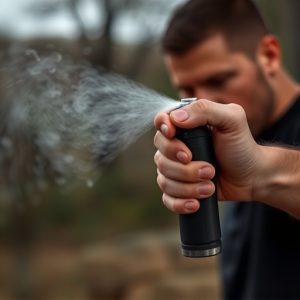Pepper Spray Storage, Shelf Life & Disposal: Maximizing Effectiveness
Capsaicin, the active ingredient in pepper spray, is sensitive to heat and light, affecting its pote…….
Capsaicin, the active ingredient in pepper spray, is sensitive to heat and light, affecting its potency. To maintain the effectiveness of pepper spray, store it cool, dry, and away from direct sunlight with a recommended shelf life of 2-3 years. Regular rotation, secure storage out of reach of children, and checking for damage or leakage are essential for optimal performance and safety. Disposal should follow local hazardous waste regulations to ensure worker and environmental safety.
“Uncover the power of capsicum and its anti-inflammatory properties with our comprehensive guide on pepper spray. From understanding the science behind this potent ingredient to mastering proper storage techniques, we explore vital aspects of pepper spray maintenance. Discover key factors influencing shelf life and learn best practices for responsible disposal. Ensure your pepper spray remains effective and safe by adhering to these essential tips, focusing heavily on optimal storage and shelf life management.”
- Understanding Capsaicin: The Science Behind the Inflammatory Agent
- Pepper Spray Storage: Ensuring Safety and Effectiveness
- Factors Affecting Shelf Life: What You Need to Know
- Best Practices for Disposing of Used Pepper Spray
Understanding Capsaicin: The Science Behind the Inflammatory Agent
Capsaicin, the compound responsible for the heat and inflammation in chili peppers, serves as a powerful deterrent in pepper spray. Understanding its properties is key to appreciating the effectiveness of such sprays as a self-defense tool. When used in pepper spray, capsaicin irritates the eyes, nose, throat, and skin, causing temporary incapacitation. This reaction is due to capsaicin binding to specific receptors in the body, triggering a response that leads to inflammation and discomfort.
The science behind capsaicin’s inflammatory nature also informs its storage and shelf life considerations for pepper spray. Since it’s sensitive to heat and light, proper storage involves keeping the spray in cool, dry places, away from direct sunlight. This ensures its potency remains intact, as exposure to extreme temperatures or UV rays can degrade the capsaicin over time. Knowing the right storage conditions is not just about preserving the effectiveness of pepper spray; it’s also about ensuring the safety and reliability of a crucial self-defense tool, especially when relying on its immediate availability in an emergency.
Pepper Spray Storage: Ensuring Safety and Effectiveness
Storing pepper spray properly is essential to maintain its safety and effectiveness. It’s recommended to keep it in a cool, dry place away from direct sunlight and heat sources. Pepper spray has a shelf life of approximately 2-3 years, depending on the manufacturer’s instructions. After this period, its potency may decrease, so regular rotation is key.
When not in use, store pepper spray in a secure location, out of reach of children and unauthorized individuals. It’s best to keep it in its original packaging with all labels intact for easy identification. Avoid leaving it in your vehicle, as extreme temperatures can impact its performance. Proper storage ensures that you have the best chance of being protected when you need it most.
Factors Affecting Shelf Life: What You Need to Know
The shelf life of capsaicin inflammatory agent deterrent spray, like any other product, is influenced by a multitude of factors. Understanding these variables is crucial for consumers and professionals alike to ensure optimal performance and safety. One key factor is storage conditions. Extreme temperatures, whether too hot or cold, can accelerate the breakdown of the active ingredient, reducing its potency over time. It’s recommended to store such sprays in cool, dry places away from direct sunlight.
Another significant aspect is exposure to moisture and oxygen. Capsaicin-based sprays are sensitive to these elements, which can lead to oxidation and degradation. Exposure to humidity can also affect the spray’s consistency and effectiveness. Proper container design plays a role in mitigating these issues, with airtight packaging often extending shelf life. Additionally, checking for any signs of damage or leakage upon purchase is vital to prevent contamination and ensure the product remains effective.
Best Practices for Disposing of Used Pepper Spray
When disposing of used pepper spray, safety should be your top priority. Empty cans should never be disposed of like regular trash due to their potent irritant properties. Instead, follow local regulations for hazardous waste disposal. Many areas require that pepper spray be taken to designated drop-off points or collection centers specifically designed for such products. This minimizes risk to waste management workers and the environment.
Proper storage and understanding pepper spray’s shelf life are also crucial. Storing unused cans in a cool, dry place, away from heat sources and direct sunlight, will help maintain their potency. Check product labels for expiration dates; unlike food items, pepper spray does not typically have a “use by” date, but its effectiveness can diminish over time. Regularly inspecting your supply ensures you’re prepared with a reliable deterrent when needed.
Capsaicin pepper spray is a powerful tool for self-defense, but proper storage and understanding its shelf life are crucial for ensuring its effectiveness. By learning about capsaicin’s properties, storing it safely, and disposing of used cans responsibly, you can maximize its potential as a deterrent. Remember, regular maintenance and awareness of the storage conditions will help keep your pepper spray ready when you need it most.


